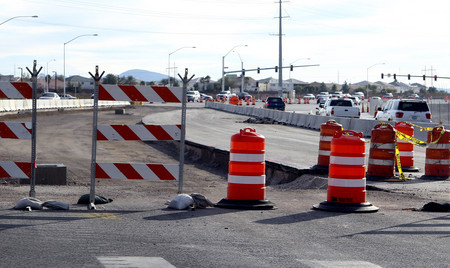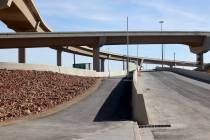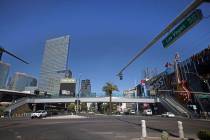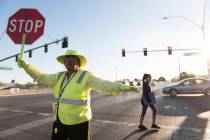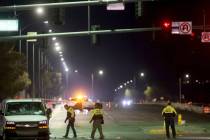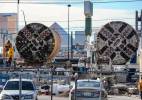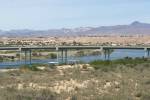If this looks familiar, you use St. Rose Parkway
As individuals, St. Rose and Martin Luther King Jr. were idolized for their unrivaled levels of passion and commitment to secure peace and freedom.
On pavement, they're a mess.
For months we've harped on the molasseslike pace of invisible crews "working" to improve Martin Luther King Boulevard. Anyone who must drive the road knows the scene: Lanes that seem perfectly fine are blocked by orange cones; ruts, bumps and potholes jolt vehicles in open lanes. The only element that moves quickly and consistently is the completion date (which is still up in the air).
Well, the folks in the Green Valley area have their very own Martin Luther King, and it's called St. Rose Parkway.
In March, the Nevada Department of Transportation embarked on its project to widen the road to four lanes in each direction between the Las Vegas Beltway and Coronado Center. The agency anticipated it would take five to six months to finish; but here it is February and orange cones still suffocate the corridor, causing significant backups because commuters are forced to squeeze into two lanes.
Not all endeavors to improve roadways move along smoothly, and this is certainly one of them.
"The huge amount of delays is concerning to residents and businesses and deservedly so," said Kent Cooper, the transportation agency's assistant director. "This took way longer than anticipated; obviously it's not the way we want a job to go."
Frustrated motorists who say they have witnessed the road torn up, paved, then ripped up again, have their own theory of what's going on along St. Rose Parkway.
"It's like it's job security, that's all I can think of," Linda Ellen theorized. "They put the road in and then tear it apart as fast as they can. We haven't had that road open in so long I can't remember. We go miles out of our way just to avoid it. It's so frustrating."
John Delaberta is even more peeved.
"They're the most incompetent, lazy workers," he said. "I have to believe it's corruption. When you get a contract to put a road in and six months later repave it, you're getting some kind of kickback."
Before we delve into the unforeseen obstacles the Department of Transportation says have stalled the work, allow me to answer the big question: Cooper estimated the road will fully open the first week of March. It will be bumpy for a bit, because the temperature needs to be around 60 degrees before the permanent layer of asphalt is put down. Expect a smooth ride by the end of May.
Before a project such as this begins, transportation officials meet with utility representatives to coordinate the work. Their hope is to identify the location of various pipes, lines and cables so the road won't be cut, paved and cut again. But this strategy isn't always successful, which was the case on this project.
When crews began the excavation work, they immediately struck two Cox Cable fiber optic lines. It took several weeks to figure out how and where to move the lines without interrupting cable service to residents. Next, workers hit a Nevada Energy vault and had to redesign the project as well as work with the company to determine where to place new lines.
These problems caused major delays as all the agencies tried to address the problems and schedule crews to fix them.
Years ago, fiber optic lines were installed throughout the valley, and there was no dependable tracking device to determine where they were. Cooper said the department has since created a system so utilities and government entities know exactly where they are.
"When it first came out, they put them in a whole bunch of places," Cooper said. "Now they have GPS coordinates so it's getting better, but we're still hitting the stuff they put in years ago."
Motorists might believe a road is paved and ready to open, but in reality a utility has done some work and placed a thin layer of asphalt over holes for safety reasons. The next utility might come in a week later and do the same.
The transportation department relocated utility and cable lines outside of the roadway's path so traffic will not be interrupted in the future if the utilities need to be repaired. Cooper said when roads are finished, a five-year "no-cut" policy is put in place, meaning anyone wanting to work on anything below St. Rose Parkway, they better start burrowing.
"It's been frustrating for the public; residents say, 'Gosh, this seems like it's never going to end,'" Cooper said. "We're near the end."
If you have a question, tip or tirade, call Adrienne Packer at 702-387-2904, or send an e-mail to roadwarrior@reviewjournal .com. Please include your phone number.
On Monday, city of Las Vegas crews embark on a roadway improvement project on Durango Drive between Cheyenne Avenue and Alexander Road. Lane restrictions will be in effect on weekdays, and sidewalks may be closed around the clock. The work, which includes patching the road and placing an asphalt overlay, is expected to last five months.
Over the next four months, watch for lane restrictions on Village Center Circle, on Hills Center Drive between Village Center and Lake Mead Boulevard, and on Town Center Drive between Village Center and Summerlin Parkway. Traffic restrictions along with sidewalk closures could be in effect around the clock on weekdays. City of Las Vegas crews are resurfacing the roads and replacing gutters, curbs and sidewalks.
Road widening along U.S. 93 south of Hoover Dam is likely to cause delays for commuters traveling next week between Las Vegas and Arizona. On Monday and Wednesday, delays could be up to an hour as blasting and cleanup work is done. Also, 15-minute delays are expected on the 17-mile stretch south of the dam while the Arizona Department of Transportation does paving work.
Expect lane closures and shifting on Craig Road for the next eight weeks as the city of North Las Vegas begins converting the Craig Ranch Golf Course into a regional park. The city is installing sewer and water lines below the eastbound lanes of Craig.
Over the next 10 months, road closures are expected on portions of McWilliams Avenue, Ninth Street and Encanto Drive as the city of Las Vegas begins work Monday on the new Neon Boneyard Park.
North Fifth Street is closed from Lake Mead Boulevard to Las Vegas Boulevard. Main Street is closed from Las Vegas Boulevard to Owens Avenue. Keep an eye out for detour signs because the closures are expected to last another four months.
LAS VEGAS REVIEW-JOURNAL



